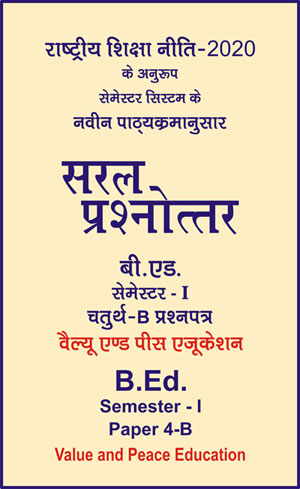|
बी एड - एम एड >> बी.एड. सेमेस्टर-1 प्रश्नपत्र-IV-B - वैल्यू एण्ड पीस एजुकेशन बी.एड. सेमेस्टर-1 प्रश्नपत्र-IV-B - वैल्यू एण्ड पीस एजुकेशनसरल प्रश्नोत्तर समूह
|
5 पाठक हैं |
||||||
बी.एड. सेमेस्टर-1 प्रश्नपत्र-IV-B - वैल्यू एण्ड पीस एजुकेशन (अंग्रेजी भाषा में)
Question- Explain the effect of Religion on Value of Life.
Answer -
The United States remains a highly religious nation. A large majority of Americans say they belong to a particular faith, and similarly large numbers express agreement with statements about key religious beliefs and behaviors. There have been only modest changes in the level of agreement with these statements over the past decade. About eight-in-ten (83%) say they never doubt the existence of God, and comparable percentages agree that prayer is an important part of their life (78%), and that “we will all be called before God at the Judgment Day to answer for our sins” (78%).
The percentage of Americans agreeing with all three statements has changed very little since the first Pew Research values survey in 1987. That year, 68% of respondents agreed with all three; this year, 69% do so. There has been a modest increase over this period in what might be considered enthusiastic religious expression: the percentage who completely agree with all three statements rose from 33% in 1987 to 44% by 1994; this year 40% completely agree with all three.
Yet despite the strongly religious character of the United States, the share of Americans who do not affiliate with a religious tradition has been growing (see Feb. 2008 “The U.S. Religious Landscape”). Overall, 16% of Pew Research respondents interviewed in 2009 say they are atheist, agnostic or “nothing in particular.” Generational change is the principal mechanism driving this growth. Among those in the Millennial age cohort, or Generation Y – Americans born after 1976 – 25% are not affiliated with a religious tradition. By comparison, among Baby Boomers just 13% are unaffiliated.
In both the 2006 and 2008 elections, religiously unaffiliated and secular voters had a significant impact on the outcome, boosting the fortunes of Democratic candidates at the state and national levels. Currently, 17% of Democrats and 21% of independents are unaffiliated, compared with just 7% of RepublicAnswer Fewer Democrats and independents are regular churchgoers as well: nearly half of Democrats (48%) and 52% of independents attend worship services only a few times a year or less often; the figure for Republicans is 33%. Looked at another way, more than half of Republicans (52%) attend church at least once a week, compared with 36% of Democrats and 32% of independents.
Democrats and independents also are less likely than Republicans to express agreement with traditional religious beliefs, though solid majorities of both groups do so. The percentage of Democrats agreeing with all three statements about religious belief and practice fell sharply after 1999 (from 76% that year to 62% in 2007), but rose over the past two years to 68%. Currently, 75% of Republicans agree with all three statements, down slightly from 2007 when 79% agreed with all three. Somewhat fewer independents express agreement. (66% now agree with all three statements).
The Democratic Party is much more racially diverse than the Republican Party, and this diversity affects the overall levels of religiosity expressed by Democrats. African-Americans are far more likely than whites to agree with all three statements (91% of non-Hispanic blacks did so in 2009, compared with 65% of non-Hispanic whites). The partisan gap in religiosity is considerably larger when considering only non-Hispanic white respondents, with just 57% of white Democrats expressing agreement with all three statements. This compares with 74% of white Republicans and 63% of white independents.
|
|||||













